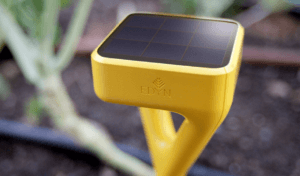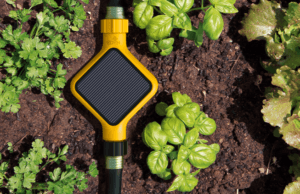The Garden of Edyn

Edyn is here to connect your garden and make you the green thumb you always wanted to be.
Connecting an Age Old Industry
Irrigation, an industry whose best practices have long relied on rigid, preset processes, is beginning to adapt. The Internet of Things has provided an entry point for new, smarter players in the industry and is forcing incumbents to get connected. In the past, the role of many businesses in irrigation stopped when the product was sold. Now, smart connected products have transformed the supply chain and increased the interface between businesses, their end consumers and the environment.[1] Connectivity throughout the supply chain is changing its boundaries, allowing businesses to optimize the use of their products and allowing the customer to capture more value. Many players in the industry have changed their business models from a focus on product development to integrated product and system development, using data from sensors to enable products to communicate with each other and with their users.
Edyn: Connecting Your Garden
Pictured above: The Edyn Garden Sensor[2]
Jason Aramburu, founder of Edyn, is an ecologist and soil scientist who focuses on carbon neutral products in the irrigation industry. Aramburu started a Kickstarter campaign in 2014 for his Edyn garden products that immediately received tremendous support and ultimately connected him with his current backers. Edyn currently sells two products, the Edyn Garden Sensor and Edyn Water Valve, that work together to optimize gardens for individual home owners and small farmers. The way that these products work is as follows. The Garden Sensor sends a harmless electrical signal through the soil that assesses soil nutrition, moisture, fertilizer levels and acidity. The sensor also tracks sunlight and weather patterns which, along with the data from the soil and information from soil science databases, determines how much water and what fertilizers are needed.[3] The system even recommends plants and fertilizers based on the type of soil and sunlight exposure in the garden. All of this information is available to the customer on the Edyn mobile application. The Edyn Valve further optimizes this process by managing the existing watering system through a simple hook up. The Valve waters the garden based on its analysis and the specific plants in the garden, allowing the customer to save water since he or she will now know exactly what the garden needs[4].
Edyn’s business model creates a constant point of contact with the customer. From any location, Edyn gardeners and farmers can check on the status of their gardens and make decisions based on the Edyn software — or rely on Edyn to make the decision for them. Continued use of the products and software develops more effective practices over time as more data is processed. Edyn’s constant contact and improvement creates customer loyalty and ultimately increases the switching costs to competitor products, since Edyn controls the data. Customers who do switch will have to sacrifice their data in hopes of a new, more effective platform.
Pictured Above: The Edyn Garden Valve[5]
The Future of Farming and Irrigation
Connectivity will continue to transform the irrigation and farming industries’ operating models in years to come. As businesses continue to connect products and build platforms, the landscape of the industry will change (pun intended), unforeseen opportunities will arise and data systems will be the true driver of competitive advantage.[6] Leaders in smart irrigation will create networks of products that create value by optimizing the supply chain like Edyn does for the gardener.
Word Count: 630
Sources:
[1] M. Porter and J. Heppelmann, “How smart, connected products are transforming
competition,” Harvard Business Review (Nov. 2014), https://hbr.org/2014/11/how-smartconnected-products-are-transforming-competition
[2] Edyn Homepage, Accessed 11.17.16, https://edyn.com
[3] Edyn: Welcome to the Connected Garden,” Kickstarter (2014), https://www.kickstarter.com/projects/edyn/edyn-welcome-to-the-connected-garden
[4] Edyn Homepage, Accessed 11.17.16, https://edyn.com
[5] Ibid.
[6] The Economist, “The language of the internet of things” (Sept. 6, 2014).





Interesting post. I wonder if this is a niche product for a small subset of hobbyists or if there are ways to scale these technologies to make them more broadly applicable? Another post summarized the application of “Precision Hawk” drone scans for farmers, and it sounded like much of that technology included the functions/capabilities of the Edyn family of products. It may be the case that this is simply a smaller niche market, but it would be interesting to compare the economics of a drone compared to a number of scattered, embedded sensors in a broader application like agriculture.
This is very interesting, thank you!
A few concerns on scalability and maintenance: How affordable are these products? How durable are they and how often do they need maintenance/replacement? Although this might indeed shape the future, a high upfront price (esp. for large fields that require many devices) and increased maintenance costs will probably hamper the expansion and potentially threaten the viability of this proposal.
A few thoughts on additional opportunities: this device could also include additional compartments for fertilizers or pesticides and can even spray when required (or at the user’s command). This will make agriculture an even easier job and reduce labor requirements.